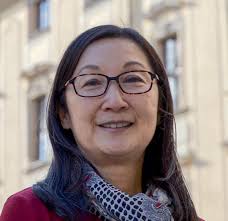
Get the latest updates in your inbox and sign up for more info!
“Freshness, innovation and the ability to see the child’s point of view”. Jury president, Junko Yokota, describes the criteria of the Hans Christian Andersen Award and the great work of the jury.
The Hans Christian Andersen Award, organised and promoted by IBBY, is a long emotional journey. After reviewing how the award works in detail, BCBF interviewed the Jury President, Junko Yokota.
This year, the winners were Albertine (Illustrator) and Jacqueline Woodson (Author).
Junko Yokota describes all the great work behind the jury’s choices and the selection criteria, from receiving the applications through to the shortlist and final decision on the winners.
What are the duties of a Jury President?
The Jury President is an elected non-voting member of the IBBY Executive Committee. The work begins by vetting the nominees for jury members submitted by the national sections and recommending that as balanced a jury as possible be chosen by the IBBY Executive Committee. Once the jury is appointed, I maintain periodic contact with members so that we can get to know each other and clear up any questions regarding procedures. My biggest role is to run the jury meetings. I try to ensure that each jury member is able to express his/her views, feel that the points made have been heard and considered, and so ensure full commitment on the part of every member. My next responsibilities revolve around working with the Executive Director to prepare the Press Release for the Shortlist, and later the announcement of the winner. Finally, I will write and deliver the Laudatio at the IBBY Congress where the winners receive their medals.
Would you please describe the great work of the jury behind the Award? How do you arrive at this shortlist?
The IBBY Secretariat is responsible for the bulk of the organisational work. They solicit nominations from national sections, and manage the materials submitted: dossiers, physical copies of books, and digital files of all materials. The digital material is organized into a digital file cabinet of sorts, and a complete set distributed to each jury member. Jury members then spend the bulk of a year reading, studying, and analysing the nominees and their works. Each jury member submits a list of their personal choices for author and illustrator, and a long list is compiled from these nominations.
The jury met in January, this time at the International Youth Library in Munich, a sister organization of IBBY with which we share a common founder, Jella Lepman. We have access to all the books, and the debate is spirited debate as we consider each and every nominated candidate. We talk about the merits of each, and then in later rounds, compare candidates, looking for the those who best meet the criteria. This is a very difficult task, as each nominee is the winner of his/her own country’s vote. We have rounds of voting, discussion, looking at the books and our notes, repeating the process until we determine who will be on the shortlist.
We're very curious to know more about the criteria used for the nominees: what qualities must a writer or illustrator have to be nominated for the H. C. Andersen Award?
The criteria used to assess the nominations include the nominee’s aesthetic and literary quality but also the freshness and innovation of each nominee’s work; the ability to see the child’s point of view and to prompt their curiosity; and the continuing relevance of the nominee’s work to children and young people. The Award is based on the entire body of work.
I am honoured to have served with the following jury members:
Mariella Bertelli (Canada), Denis Beznosov (Russia), Tina Bilban (Slovenia), Yasuko Doi (Japan), Nadia El Kholy (Egypt), Viviane Ezratty (France), Eva Kaliskami (Greece), Robin Morrow (Australia), Cecilia Ana Repetti (Argentina) and Ulla Rhedin (Sweden). Elda Nogueira (Brazil) represented the IBBY President and Executive Director, and Liz Page acted as Jury Secretary.
The criteria used to assess the nominations include the nominee’s aesthetic and literary quality but also the freshness and innovation of each nominee’s work; the ability to see the child’s point of view and to prompt their curiosity; and the continuing relevance of the nominee’s work for children and young people. The Award is based on the entire body of work.
IBBY National sections submitted 34 author nominees and 36 illustrator nominees. From this pool of incredibly highly qualified candidates, the jury deliberated on each nominee, carefully and thoroughly assessing each candidate while maintaining discussions related to the criteria. The shortlist of six authors and six illustrators was announced in January, and we hope you have had a chance to view the video to see and hear each candidate introduce their work.

We talk about the merits of each, and then in later rounds, compare candidates, looking for the those who best meet the criteria.
The illustrators shortlisted for the award this year are: Isabelle Arsenault from Canada, Seizo Tashima from Japan, Sylvia Weve from the Netherlands, Iwona Chmielewska from Poland, Elena Odriozola from Spain, and Albertine from Switzerland.
The authors shortlisted for the award are: María Cristina Ramos from Argentina, Bart Moeyaert from Belgium, Marie-Aude Murail from France, Farhad Hassanzadeh from Iran, Peter Svetina from Slovenia, and Jacqueline Woodson from the USA.
On May 4, IBBY held the annual Press Conference and the winners were announced. The awards went to Albertine (Illustrator) and Jacqueline Woodson (Author).
The award ceremony will be held in 2021 at the 37th IBBY Congress in Moscow. Meanwhile, please continue to celebrate each of the nominees, the 12 shortlisted candidates.